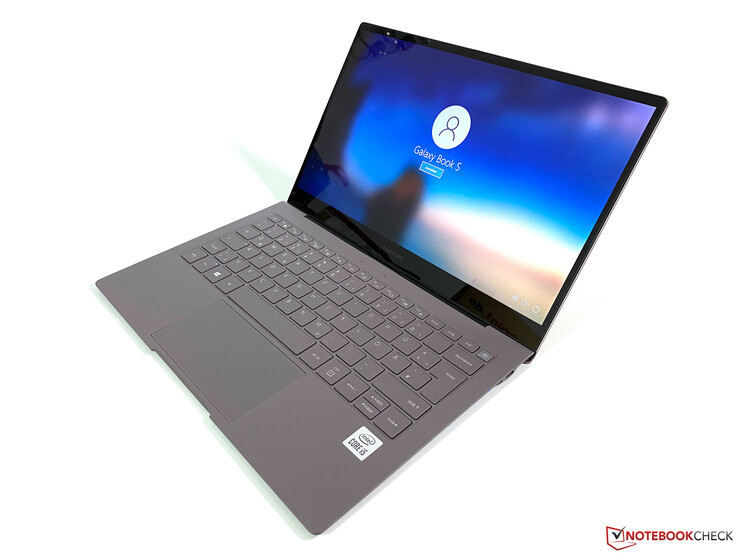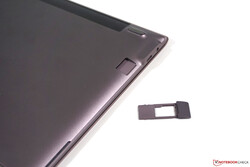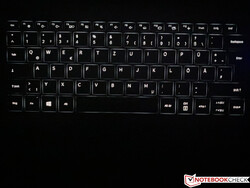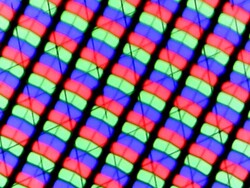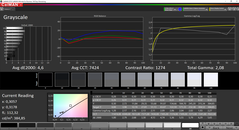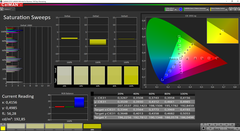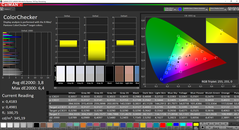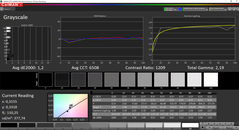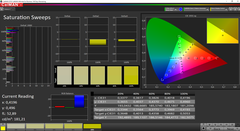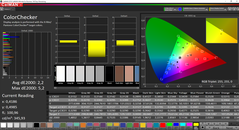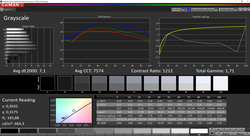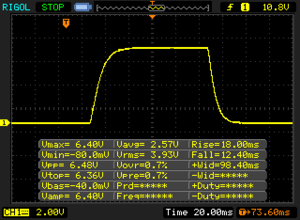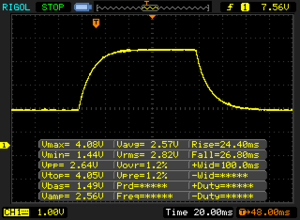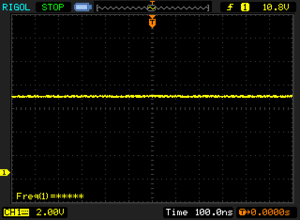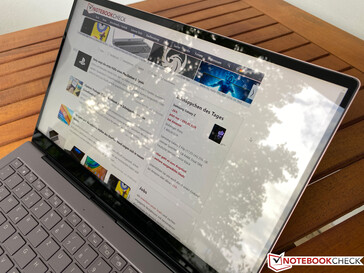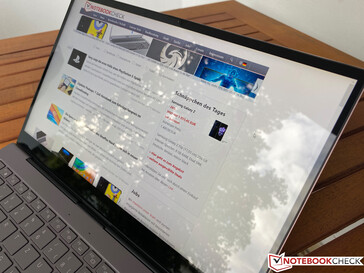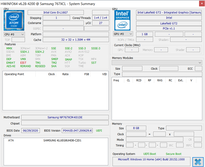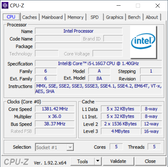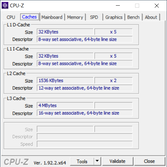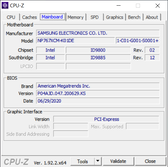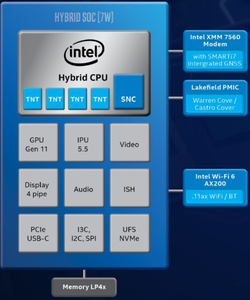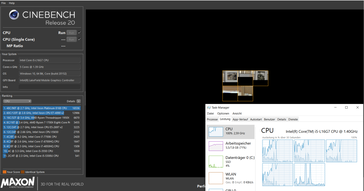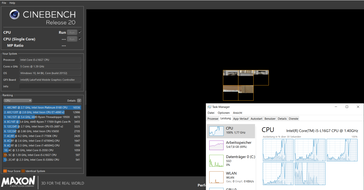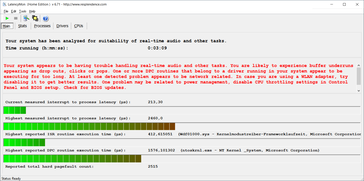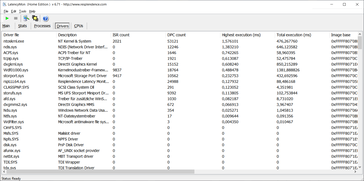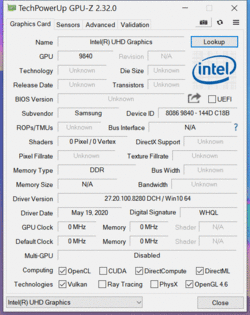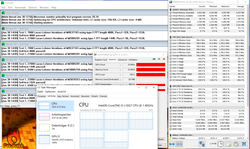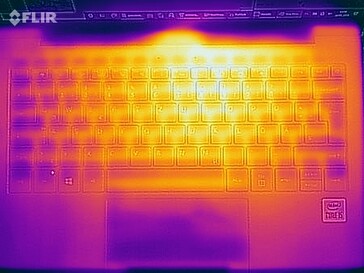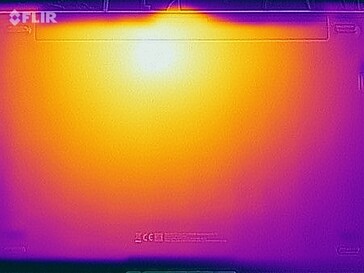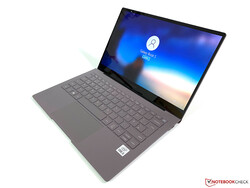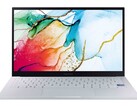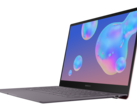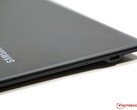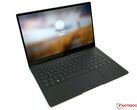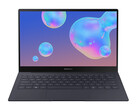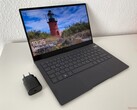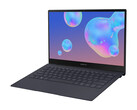Samsung Galaxy Book S Laptop Review: Lakefield with initial problems
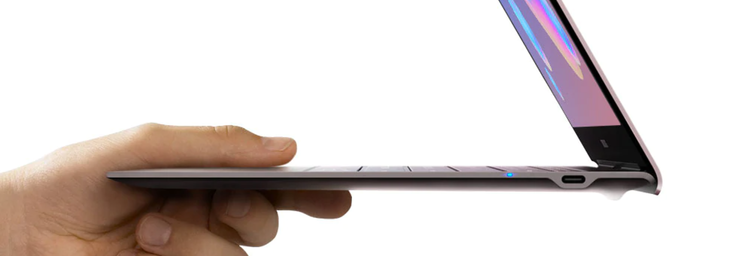
We recently reviewed the Samsung Galaxy Book S with the ARM processor, and the South Korean manufacturer now offers its compact ultrabook with an Intel processor. It is the brand-new Lakefield hybrid chip, which is once again completely passively cooled. However, the Intel model does not include an LTE modem in all regions anymore, and the battery runtimes are also shorter. The x86 does improve the compatibility in return. The two versions are almost similarly priced, so we want to find out which device is better.
We have purchased our unit from Samsung's official online shop, so it is a regular retail unit and not a selected press sample from the manufacturer. For a price of 1129 Euros (~$1275), you get the Intel Lakefield processor, 8 GB RAM, and 256 GB storage. The 1080p touchscreen is basically identical as well, but Samsung equips the Intel SKU with a special Outdoor+ mode, which is supposed to increase the brightness to 600 cd/m².
The case, the ports, the speakers, as well as the input devices (except for the color of the background illumination) are identical to the recently reviewed ARM version. We will focus on the differences of the two models in the following review and take a closer look at the new Intel processor.
Note: The German review unit was not equipped with an LTE modem, but it is included in other countries. The review sections regarding the missing LTE modem are therefore not representative for all regions.
Rating | Date | Model | Weight | Height | Size | Resolution | Price |
|---|---|---|---|---|---|---|---|
| 85.1 % v7 (old) | 07 / 2020 | Samsung Galaxy Book S Intel i5-L16G7, UHD Graphics G7 (Lakefield GT2 64 EU) | 940 g | 11.8 mm | 13.30" | 1920x1080 | |
| 86.2 % v7 (old) | 06 / 2020 | Samsung Galaxy Book S SD 8cx, Adreno 680 | 951 g | 11.8 mm | 13.30" | 1920x1080 | |
| 89.6 % v7 (old) | 05 / 2020 | Apple MacBook Air 2020 i3 i3-1000NG4, Iris Plus Graphics G4 (Ice Lake 48 EU) | 1.3 kg | 16.1 mm | 13.30" | 2560x1600 | |
| 88.8 % v7 (old) | 03 / 2020 | Dell XPS 13 9300 i5 FHD i5-1035G1, UHD Graphics G1 (Ice Lake 32 EU) | 1.2 kg | 14.8 mm | 13.40" | 1920x1200 | |
| 85.9 % v7 (old) | 06 / 2020 | Acer Swift 3 SF313-52-52AS i5-1035G4, Iris Plus Graphics G4 (Ice Lake 48 EU) | 1.2 kg | 16.6 mm | 13.50" | 2256x1504 | |
| 84 % v7 (old) | 02 / 2020 | Microsoft Surface Laptop 3 13 Core i5-1035G7 i5-1035G7, Iris Plus Graphics G7 (Ice Lake 64 EU) | 1.3 kg | 14.5 mm | 13.50" | 2256x1504 |
Case - The Intel SKU is also below 1 kg
The Intel version of the Galaxy Book S is even slightly lighter at 940 grams, but this is not noticeable even in a direct comparison. Together with the compact power adapter (91 grams/3.2 oz including USB-C cable), the total travel weight is still just slightly above 1 kg (~2.2 lb).
Connectivity - Galaxy Book S with Wi-Fi 6
The ports are identical to the ARM version of the Galaxy Book S. There is a USB-C port on each side (USB 3.1 Gen.1 w/ DisplayPort-Alt), which can also be used to charge the laptop. You also get a 3.5 mm stereo jack and a microSD reader.
The maximum transfer rate in combination with our reference card from Toshiba (Exceria Pro M501 64 GB UHS-II) is 82.4 MB/s, so it is identical with the ARM model. The average transfer rate when you copy pictures is a bit lower at 63.9 MB/s.
Samsung does not ship the German model with an LTE modem, so one major advantage of the ARM SKU is gone. In return, customers get a slightly faster Wi-Fi 6 module from Intel (AX200), but the transfer rates in combination with our Netgear router (Nighthawk AX12) are below our expectations. The results are better compared to the ARM Galaxy Book S, but most users will probably not notice the difference.
| SD Card Reader | |
| average JPG Copy Test (av. of 3 runs) | |
| Dell XPS 13 9300 i5 FHD (Toshiba Exceria Pro M501 64 GB UHS-II) | |
| Samsung Galaxy Book S (Toshiba Exceria Pro M501 64 GB UHS-II) | |
| Samsung Galaxy Book S Intel (Toshiba Exceria Pro M501 64 GB UHS-II) | |
| Average of class Subnotebook (18.4 - 142, n=13, last 2 years) | |
| maximum AS SSD Seq Read Test (1GB) | |
| Dell XPS 13 9300 i5 FHD (Toshiba Exceria Pro M501 64 GB UHS-II) | |
| Samsung Galaxy Book S (Toshiba Exceria Pro M501 64 GB UHS-II) | |
| Samsung Galaxy Book S Intel (Toshiba Exceria Pro M501 64 GB UHS-II) | |
| Average of class Subnotebook (22.5 - 207, n=13, last 2 years) | |
Input Devices - Keyboard illumination still hardly usable
The input devices are identical to the recently reviewed ARM model. Our test unit in Earthy Gold, however, does not have a green keyboard illumination, but a white one. The basic issue is still the same though, because the backlight is controlled by a sensor, which is sitting in the lower right display bezel. The sensor will only activate the illumination when it is almost pitch black, and we could not activate it in dim environments. The visibility of the keyboard is not perfect due to the color, either, and we would have wanted a manual control in many situations. The illumination could also be a bit stronger. Samsung should definitely fix this issue.
Display - Outdoor+ Mode is much brighter
A quick look at the specs suggests that Samsung uses the same 1080p touchscreen, and our measurement results are also very similar for the most part, but there are two important differences: The Intel SKU supports the so called Outdoor+ mode, which increases the brightness to ~650 cd/m². We cannot detect any PWM flickering, either, which was the case on the ARM Galaxy Book S. Therefore, it seems to be a different panel (we could not find out the exact panel-ID on the ARM model). Similar to the ARM model, the subjective picture impression is very good. The integrated brightness sensor only controls the keyboard illumination; the screen brightness cannot be adjusted automatically.
Note: Samsung says that the Outdoor+ mode will increase the brightness significantly, which also increases the power consumption. The Outdoor+ mode is also automatically deactivated when you turn off the screen or when you close the lid, for example. You always have to activate the mode manually, so we use the results without the Outdoor+ mode for our rating (for both the power consumption and the battery runtime).
| |||||||||||||||||||||||||
Brightness Distribution: 88 %
Center on Battery: 387 cd/m²
Contrast: 1283:1 (Black: 0.3 cd/m²)
ΔE ColorChecker Calman: 3.8 | ∀{0.5-29.43 Ø4.78}
calibrated: 2.2
ΔE Greyscale Calman: 4.6 | ∀{0.09-98 Ø5}
97.2% sRGB (Argyll 1.6.3 3D)
65.3% AdobeRGB 1998 (Argyll 1.6.3 3D)
71.3% AdobeRGB 1998 (Argyll 3D)
97.2% sRGB (Argyll 3D)
70% Display P3 (Argyll 3D)
Gamma: 2.2
CCT: 7424 K
| Samsung Galaxy Book S Intel BOE07E7, IPS, 1920x1080, 13.3" | Samsung Galaxy Book S BOE, IPS, 1920x1080, 13.3" | Apple MacBook Air 2020 i3 APPA042, IPS, 2560x1600, 13.3" | Dell XPS 13 9300 i5 FHD SHP14CB, IPS, 1920x1200, 13.4" | Acer Swift 3 SF313-52-52AS BOE08BC, IPS, 2256x1504, 13.5" | Microsoft Surface Laptop 3 13 Core i5-1035G7 Sharp LQ135P1JX51, IPS, 2256x1504, 13.5" | |
|---|---|---|---|---|---|---|
| Display | 0% | 2% | 1% | -3% | ||
| Display P3 Coverage (%) | 70 | 70.3 0% | 71.5 2% | 70.3 0% | 65.7 -6% | |
| sRGB Coverage (%) | 97.2 | 98 1% | 99.4 2% | 99.8 3% | 98.6 1% | |
| AdobeRGB 1998 Coverage (%) | 71.3 | 71.6 0% | 73.5 3% | 71.3 0% | 67.8 -5% | |
| Response Times | 6% | 16% | -13% | 0% | -27% | |
| Response Time Grey 50% / Grey 80% * (ms) | 51.2 ? | 48.8 ? 5% | 38.4 ? 25% | 60 ? -17% | 50 ? 2% | 59.2 ? -16% |
| Response Time Black / White * (ms) | 30.4 ? | 28.4 ? 7% | 28.4 ? 7% | 33.2 ? -9% | 31 ? -2% | 41.6 ? -37% |
| PWM Frequency (Hz) | 9524 ? | 119000 ? | 2500 ? | 192 ? | 21740 ? | |
| Screen | 2% | 29% | 17% | 6% | 23% | |
| Brightness middle (cd/m²) | 385 | 383 -1% | 416 8% | 619 61% | 456 18% | 403.4 5% |
| Brightness (cd/m²) | 354 | 355 0% | 403 14% | 591 67% | 432 22% | 397 12% |
| Brightness Distribution (%) | 88 | 88 0% | 95 8% | 91 3% | 88 0% | 89 1% |
| Black Level * (cd/m²) | 0.3 | 0.36 -20% | 0.34 -13% | 0.35 -17% | 0.32 -7% | 0.34 -13% |
| Contrast (:1) | 1283 | 1064 -17% | 1224 -5% | 1769 38% | 1425 11% | 1186 -8% |
| Colorchecker dE 2000 * | 3.8 | 3.1 18% | 0.9 76% | 3 21% | 3.49 8% | 0.94 75% |
| Colorchecker dE 2000 max. * | 6.4 | 5.3 17% | 1.4 78% | 8.2 -28% | 8.4 -31% | 2.92 54% |
| Colorchecker dE 2000 calibrated * | 2.2 | 0.6 73% | 1 55% | 0.72 67% | 0.99 55% | |
| Greyscale dE 2000 * | 4.6 | 3.6 22% | 1 78% | 5.2 -13% | 5.53 -20% | 0.9 80% |
| Gamma | 2.2 100% | 2 110% | 2.2 100% | 2.14 103% | 2.41 91% | 2.13 103% |
| CCT | 7424 88% | 6743 96% | 6629 98% | 6340 103% | 6675 97% | 6620 98% |
| Color Space (Percent of AdobeRGB 1998) (%) | 65.3 | 63.9 -2% | 66.9 2% | 65 0% | 62.3 -5% | |
| Color Space (Percent of sRGB) (%) | 97.2 | 97.6 0% | 99.3 2% | 100 3% | 98.7 2% | |
| Total Average (Program / Settings) | 4% /
3% | 15% /
22% | 2% /
11% | 2% /
5% | -2% /
12% |
* ... smaller is better
The average luminance is once again around 350 cd/m² and the contrast ratio is very good at 1200:1. There is a slight blue cast out of the box, and the color temperature is a bit too cool as well. Contrary to the ARM model of the Galaxy Book S, it was no problem to calibrate the display this time, and the results improved significantly. The slight color cast is completely gone, and the color deviations are also lower. Only 100% blue is still above the important mark (3). You can download the calibrated display profile in the box above.
The small sRGB color gamut is almost covered completely, in combination with the low color deviations you can also use the display to edit pictures/videos in the small color space. We also checked the screen with the Outdoor+ mode, and the much higher brightness does not impact the subjective picture quality. The black value suffers a bit, but the overall contrast ratio is still around 1200:1.
Display Response Times
| ↔ Response Time Black to White | ||
|---|---|---|
| 30.4 ms ... rise ↗ and fall ↘ combined | ↗ 18 ms rise | |
| ↘ 12.4 ms fall | ||
| The screen shows slow response rates in our tests and will be unsatisfactory for gamers. In comparison, all tested devices range from 0.1 (minimum) to 240 (maximum) ms. » 82 % of all devices are better. This means that the measured response time is worse than the average of all tested devices (20.2 ms). | ||
| ↔ Response Time 50% Grey to 80% Grey | ||
| 51.2 ms ... rise ↗ and fall ↘ combined | ↗ 24.4 ms rise | |
| ↘ 26.8 ms fall | ||
| The screen shows slow response rates in our tests and will be unsatisfactory for gamers. In comparison, all tested devices range from 0.165 (minimum) to 636 (maximum) ms. » 87 % of all devices are better. This means that the measured response time is worse than the average of all tested devices (31.6 ms). | ||
Screen Flickering / PWM (Pulse-Width Modulation)
| Screen flickering / PWM not detected | |||
In comparison: 53 % of all tested devices do not use PWM to dim the display. If PWM was detected, an average of 8108 (minimum: 5 - maximum: 343500) Hz was measured. | |||
You can see the difference between the standard and Outdoor+ mode when you use the laptop outdoors, but the reflections on the glossy screen are still a big problem and it is not easy to capture the difference between the two modes on camera. You should still avoid reflections from light sources or bright surfaces if possible.
Performance - Galaxy Book S with reduced TDP
The Intel Lakefield hybrid processor is brand-new, and many tools still have problems to show accurate data. In theory, the Core i5-L16G7 has a TDP of 7 watts (9.5W Burst). According to our information from Intel, however, Samsung reduced the PowerLimit 1 from 7 to 5 watts (PL2 still at 9.5W). This means the following results are not representative of the performance of the Lakefield processor if it runs with the specified 7/9.5 watts.
Note: Shortly after the original German review of the Galaxy Book S was published, we got an official statement from Samsung regarding the power consumption of the Lakefield processor. It states that Samsung is planning to increase the TDP from 5 to 7 watts with an update within the next two weeks. Once the update is available, we will have another look at the performance and the surface temperatures.
Processor - Galaxy Book S with Hybrid CPU
The Core i5-L16G7 is Intel's first hybrid processor and combines four efficient Atom cores (Tremont cores, 10 nm, up to 2.8 GHz Boost) with a fast Sunny Cove core (10 nm, up to 3.0 GHz), which is also used for the current Ice Lake CPUs. Hyperthreading is not supported, so each core can only execute one thread. Please see our tech section for more details on the architecture.
The operating system decides how the load is distributed among the cores, but applications have to support the hybrid processor as well in order to utilize the fast core. The results of our initial benchmarks were pretty sobering, because the fast Sunny Cove core was not really utilized. So we were basically dealing with a quad-core Atom processor. You can use the Task manager to assign the faster core for a specific process, but this is not suitable in practice. The Cinebench R15 single-core test was improved from 88 to 111 points (+26%) when we manually selected the faster Sunny Cove core.
Cinebench R20 is a good example for the support of applications (see screenshots below). Version 20.040 cannot utilize the fast core effectively; we can see that 5 threads are executed, but the fifth core does not see much load. This changes with version 20.060, where all cores are fully utilized.
| CB R20.040 | CB R20.060 | Difference | |
|---|---|---|---|
| Single-Core | 182 Pts | 276 Pts | +51 % |
| Multi-Core | 479 Pts | 609 Pts | +22 % |
The performance is actually pretty good when the applications supports the hybrid processor, especially considering the low TDP. The Core i3-1000NG4 (Ice Lake-Y, 2 cores/4 threads) from the current MacBook Air is a good comparison. The latter is about 26% faster in the single-core test due to the higher clock, but the Lakefield chip is actually slightly faster in the multi-core test. This is pretty remarkable because the Core i3 in the MacBook Air consumes between 10-11 watts, but the Lakefield i5 is limited to 5 watts.
The support of the applications is currently still a big problem. Our Cinebench R15 Multi loop does not utilize the fifth core, so in this case you only get the performance of the four Atom cores, which falls behind the Core i3-1000NG4. The results are still not bad when you consider the different power consumptions. By the way, the performance is not reduced on battery power.
Cinebench R15: CPU Single 64Bit | CPU Multi 64Bit
Blender: v2.79 BMW27 CPU
7-Zip 18.03: 7z b 4 -mmt1 | 7z b 4
Geekbench 5.5: Single-Core | Multi-Core
HWBOT x265 Benchmark v2.2: 4k Preset
LibreOffice : 20 Documents To PDF
R Benchmark 2.5: Overall mean
| Cinebench R20 / CPU (Single Core) | |
| Average of class Subnotebook (128 - 826, n=69, last 2 years) | |
| Microsoft Surface Laptop 3 13 Core i5-1035G7 | |
| Dell XPS 13 9300 i5 FHD | |
| Acer Swift 3 SF313-52-52AS | |
| Acer Swift 3 SF313-52-52AS | |
| Apple MacBook Air 2020 i3 | |
| Average Intel Core i5-L16G7 (276 - 289, n=2) | |
| Samsung Galaxy Book S Intel | |
| Cinebench R20 / CPU (Multi Core) | |
| Average of class Subnotebook (579 - 8541, n=69, last 2 years) | |
| Microsoft Surface Laptop 3 13 Core i5-1035G7 | |
| Dell XPS 13 9300 i5 FHD | |
| Acer Swift 3 SF313-52-52AS | |
| Acer Swift 3 SF313-52-52AS | |
| Average Intel Core i5-L16G7 (609 - 686, n=2) | |
| Samsung Galaxy Book S Intel | |
| Apple MacBook Air 2020 i3 | |
| Cinebench R15 / CPU Single 64Bit | |
| Average of class Subnotebook (72.4 - 322, n=69, last 2 years) | |
| Microsoft Surface Laptop 3 13 Core i5-1035G7 | |
| Dell XPS 13 9300 i5 FHD | |
| Acer Swift 3 SF313-52-52AS | |
| Apple MacBook Air 2020 i3 | |
| Average Intel Core i5-L16G7 (88.3 - 90.7, n=2) | |
| Samsung Galaxy Book S Intel | |
| Cinebench R15 / CPU Multi 64Bit | |
| Average of class Subnotebook (327 - 3345, n=69, last 2 years) | |
| Microsoft Surface Laptop 3 13 Core i5-1035G7 | |
| Dell XPS 13 9300 i5 FHD | |
| Dell XPS 13 9300 i5 FHD | |
| Acer Swift 3 SF313-52-52AS | |
| Apple MacBook Air 2020 i3 | |
| Samsung Galaxy Book S Intel | |
| Average Intel Core i5-L16G7 (255 - 255, n=2) | |
| Blender / v2.79 BMW27 CPU | |
| Samsung Galaxy Book S Intel | |
| Average Intel Core i5-L16G7 (1897 - 2156, n=2) | |
| Apple MacBook Air 2020 i3 | |
| Acer Swift 3 SF313-52-52AS | |
| Acer Swift 3 SF313-52-52AS | |
| Microsoft Surface Laptop 3 13 Core i5-1035G7 | |
| Dell XPS 13 9300 i5 FHD | |
| Average of class Subnotebook (159 - 2271, n=72, last 2 years) | |
| 7-Zip 18.03 / 7z b 4 -mmt1 | |
| Average of class Subnotebook (2643 - 6442, n=71, last 2 years) | |
| Microsoft Surface Laptop 3 13 Core i5-1035G7 | |
| Dell XPS 13 9300 i5 FHD | |
| Acer Swift 3 SF313-52-52AS | |
| Acer Swift 3 SF313-52-52AS | |
| Apple MacBook Air 2020 i3 | |
| Average Intel Core i5-L16G7 (3174 - 3248, n=2) | |
| Samsung Galaxy Book S Intel | |
| 7-Zip 18.03 / 7z b 4 | |
| Average of class Subnotebook (11668 - 77867, n=69, last 2 years) | |
| Microsoft Surface Laptop 3 13 Core i5-1035G7 | |
| Dell XPS 13 9300 i5 FHD | |
| Acer Swift 3 SF313-52-52AS | |
| Acer Swift 3 SF313-52-52AS | |
| Apple MacBook Air 2020 i3 | |
| Average Intel Core i5-L16G7 (7230 - 7943, n=2) | |
| Samsung Galaxy Book S Intel | |
| Geekbench 5.5 / Single-Core | |
| Average of class Subnotebook (726 - 2350, n=64, last 2 years) | |
| Dell XPS 13 9300 i5 FHD | |
| Apple MacBook Air 2020 i3 | |
| Acer Swift 3 SF313-52-52AS | |
| Acer Swift 3 SF313-52-52AS | |
| Average Intel Core i5-L16G7 (797 - 856, n=2) | |
| Samsung Galaxy Book S Intel | |
| Samsung Galaxy Book S | |
| Geekbench 5.5 / Multi-Core | |
| Average of class Subnotebook (2557 - 17218, n=64, last 2 years) | |
| Dell XPS 13 9300 i5 FHD | |
| Acer Swift 3 SF313-52-52AS | |
| Acer Swift 3 SF313-52-52AS | |
| Samsung Galaxy Book S | |
| Apple MacBook Air 2020 i3 | |
| Average Intel Core i5-L16G7 (1441 - 1826, n=2) | |
| Samsung Galaxy Book S Intel | |
| HWBOT x265 Benchmark v2.2 / 4k Preset | |
| Average of class Subnotebook (0.97 - 25.1, n=69, last 2 years) | |
| Microsoft Surface Laptop 3 13 Core i5-1035G7 | |
| Dell XPS 13 9300 i5 FHD | |
| Acer Swift 3 SF313-52-52AS | |
| Acer Swift 3 SF313-52-52AS | |
| Apple MacBook Air 2020 i3 | |
| Average Intel Core i5-L16G7 (1.44 - 1.48, n=2) | |
| Samsung Galaxy Book S Intel | |
| LibreOffice / 20 Documents To PDF | |
| Apple MacBook Air 2020 i3 | |
| Samsung Galaxy Book S Intel | |
| Average Intel Core i5-L16G7 (88.9 - 89.3, n=2) | |
| Acer Swift 3 SF313-52-52AS | |
| Acer Swift 3 SF313-52-52AS | |
| Average of class Subnotebook (38.5 - 220, n=68, last 2 years) | |
| R Benchmark 2.5 / Overall mean | |
| Samsung Galaxy Book S Intel | |
| Average Intel Core i5-L16G7 (0.897 - 0.987, n=2) | |
| Apple MacBook Air 2020 i3 | |
| Acer Swift 3 SF313-52-52AS | |
| Acer Swift 3 SF313-52-52AS | |
| Dell XPS 13 9300 i5 FHD | |
| Average of class Subnotebook (0.403 - 1.456, n=70, last 2 years) | |
* ... smaller is better
The browser benchmarks are ideal to compare the Lakefield processor with the ARM Galaxy Book S. The Snapdragon CPU is just beaten in these tests, and the Lakefield chip is clearly beaten by all the other rivals in the majority of benchmarks.
* ... smaller is better
System Performance
The subjective performance impression of the Intel based Galaxy Book S is very good. The device also benefits from the "bad" distribution of the load among the cores. If one core is still available even when you stress the device, the system will still react quickly to inputs and there are no stutters, even during benchmarks. There should not be any problems when you only do daily stuff, and contrary to the ARM based Galaxy Book S, you can install and use all apps without any compatibility issues.
The overall performance level in the synthetic PCMark benchmarks is very low; the comparison devices with 15W processors just have an advantage.
| PCMark 8 Home Score Accelerated v2 | 2813 points | |
| PCMark 8 Creative Score Accelerated v2 | 3779 points | |
| PCMark 8 Work Score Accelerated v2 | 2227 points | |
| PCMark 10 Score | 2348 points | |
Help | ||
DPC-Latency - Galaxy Book S with problems
| DPC Latencies / LatencyMon - interrupt to process latency (max), Web, Youtube, Prime95 | |
| Acer Swift 3 SF313-52-52AS | |
| Samsung Galaxy Book S Intel | |
| Dell XPS 13 9300 i5 FHD | |
* ... smaller is better
Storage Solution - Galaxy Book S with UFS storage
Samsung once again uses UFS 3.0 storage for the Galaxy Book S with a storage capacity of 256 GB. After the initial installation, you can use around 187 GB. The performance of the drive is superior to conventional hard drives, but real PCIe-SSDs in the competitors are just much faster.
| Samsung Galaxy Book S Intel 256 GB UFS 3.0 Flash | Samsung Galaxy Book S 256 GB NVMe | Apple MacBook Air 2020 i3 Apple SSD AP0256 | Dell XPS 13 9300 i5 FHD Toshiba XG6 KXG60ZNV512G | Acer Swift 3 SF313-52-52AS SK Hynix BC501 HFM512GDJTNG | Microsoft Surface Laptop 3 13 Core i5-1035G7 SK hynix BC501 HFM256GDGTNG | Average 256 GB UFS 3.0 Flash | |
|---|---|---|---|---|---|---|---|
| CrystalDiskMark 5.2 / 6 | -3% | 91% | 252% | 156% | 122% | 0% | |
| Write 4K (MB/s) | 37.71 | 30.59 -19% | 34.57 -8% | 121.9 223% | 120.6 220% | 112.3 198% | 37.7 ? 0% |
| Read 4K (MB/s) | 11 | 20.26 84% | 28.48 159% | 50 355% | 46.88 326% | 42.13 283% | 11 ? 0% |
| Write Seq (MB/s) | 403.1 | 421.4 5% | 1026 155% | 1497 271% | 1044 159% | 630 56% | 403 ? 0% |
| Read Seq (MB/s) | 769 | 1232 60% | 1109 44% | 2111 175% | 1147 49% | 1023 33% | 769 ? 0% |
| Write 4K Q32T1 (MB/s) | 155.9 | 39.17 -75% | 178.4 14% | 365.9 135% | 332.4 113% | 336.6 116% | 155.9 ? 0% |
| Read 4K Q32T1 (MB/s) | 195.6 | 41.14 -79% | 557 185% | 384.6 97% | 443.3 127% | 399.6 104% | 195.6 ? 0% |
| Write Seq Q32T1 (MB/s) | 407.9 | 420.9 3% | 970 138% | 2748 574% | 1052 158% | 821 101% | 408 ? 0% |
| Read Seq Q32T1 (MB/s) | 1102 | 1047 -5% | 1513 37% | 3119 183% | 2171 97% | 2030 84% | 1102 ? 0% |
| AS SSD | 11% | 38% | 211% | 156% | 78% | 0% | |
| Seq Read (MB/s) | 945 | 1069 13% | 1135 20% | 2328 146% | 1370 45% | 1387 47% | 945 ? 0% |
| Seq Write (MB/s) | 349 | 382 9% | 1090 212% | 1137 226% | 1019 192% | 504 44% | 349 ? 0% |
| 4K Read (MB/s) | 17.79 | 16.64 -6% | 14.87 -16% | 48.07 170% | 50.8 186% | 42.35 138% | 17.8 ? 0% |
| 4K Write (MB/s) | 25.69 | 35.99 40% | 26.27 2% | 120.6 369% | 111.2 333% | 120 367% | 25.7 ? 0% |
| 4K-64 Read (MB/s) | 373.5 | 415.1 11% | 585 57% | 899 141% | 770 106% | 497.4 33% | 374 ? 0% |
| 4K-64 Write (MB/s) | 245.4 | 229.5 -6% | 154.6 -37% | 1220 397% | 713 191% | 354.9 45% | 245 ? 0% |
| Access Time Read * (ms) | 0.232 | 0.126 46% | 0.085 63% | 0.055 76% | 0.232 ? -0% | ||
| Access Time Write * (ms) | 0.144 | 0.093 35% | 0.058 60% | 0.033 77% | 0.034 76% | 0.093 35% | 0.144 ? -0% |
| Score Read (Points) | 486 | 539 11% | 713 47% | 1180 143% | 958 97% | 678 40% | 486 ? 0% |
| Score Write (Points) | 306 | 304 -1% | 290 -5% | 1455 375% | 926 203% | 525 72% | 306 ? 0% |
| Score Total (Points) | 1014 | 1086 7% | 1365 35% | 3189 214% | 2370 134% | 1520 50% | 1014 ? 0% |
| Copy ISO MB/s (MB/s) | 368.9 | 764 107% | 369 ? 0% | ||||
| Copy Program MB/s (MB/s) | 190 | 256.1 35% | 190 ? 0% | ||||
| Copy Game MB/s (MB/s) | 366.6 | 368.4 0% | 367 ? 0% | ||||
| Total Average (Program / Settings) | 4% /
5% | 65% /
60% | 232% /
228% | 156% /
156% | 100% /
94% | 0% /
0% |
* ... smaller is better
Sustained Performance Read: DiskSpd Read Loop, Queue Depth 8
GPU Performance - Throttled Ice-Lake-iGPU
The integrated graphics adapter is basically the fast G7-iGPU we know from the Ice Lake processors. Because of the low TDP, however, the core clock is much lower. The performance in the synthetic is more comparable to the old Intel UHD Graphics 620.
The iGPU is well-suited for everyday situation, and the video decoder has no problems with the playback of high-resolution videos.
Gaming is not great on the Galaxy Book S. The graphics performance drops after a little while (Fire Strike stress test not passed at 82%) and even simple titles hardly reach playable frame rates, which is also a result of the low CPU performance. You should focus on very simple titles from the Windows Store (like card games, for example).
| 3DMark 11 Performance | 1711 points | |
| 3DMark Ice Storm Standard Score | 39624 points | |
| 3DMark Cloud Gate Standard Score | 5516 points | |
| 3DMark Fire Strike Score | 1104 points | |
| 3DMark Time Spy Score | 389 points | |
Help | ||
| low | med. | high | ultra | |
|---|---|---|---|---|
| BioShock Infinite (2013) | 32.5 | 18.6 | ||
| The Witcher 3 (2015) | 12.1 | |||
| Dota 2 Reborn (2015) | 46.5 | 17.9 | 12.7 | 12 |
| Rocket League (2017) | 23 | |||
| X-Plane 11.11 (2018) | 16.9 | 9.61 | 9.05 |
Emissions - Intel version of the Galaxy Book S is also passively cooled
System Noise
Similar to the ARM model, the Intel processor in the Galaxy Book S is passively cooled and we did not notice any other electronic sounds, either.
Temperature
The surface temperatures are pretty interesting, because they are significantly lower compared to the ARM based Galaxy Book S. We can only measure 40 °C (104 °F) at the bottom at one spot, all the other measurement spots are much cooler. This begs the question why Samsung has reduced the TDP of the processor; the surface temperatures still have some headroom.
We were not able to see the GPU clock during the stress test. The CPU cores are clearly below the 1 GHz mark and you see that Prime95 is not optimized for the hybrid processor.
(+) The maximum temperature on the upper side is 38.1 °C / 101 F, compared to the average of 35.9 °C / 97 F, ranging from 21.4 to 59 °C for the class Subnotebook.
(±) The bottom heats up to a maximum of 40 °C / 104 F, compared to the average of 39.3 °C / 103 F
(+) In idle usage, the average temperature for the upper side is 24.4 °C / 76 F, compared to the device average of 30.8 °C / 87 F.
(+) The palmrests and touchpad are reaching skin temperature as a maximum (32.4 °C / 90.3 F) and are therefore not hot.
(-) The average temperature of the palmrest area of similar devices was 28.2 °C / 82.8 F (-4.2 °C / -7.5 F).
Energy Management
Power Consumption
Our consumption measurements are pretty interesting, because the Intel version draws more power than the ARM Galaxy Book S in every scenario. There are still advantages compared to rivals with 15W CPUs, bit the difference is often not that big. The power consumption during the stress test quickly drops from 20 to about 13 watts, so the included 25W power adapter is completely sufficient. The idle consumption is increased by 2W when you activate the Outdoor+ mode.
| Off / Standby | |
| Idle | |
| Load |
|
Key:
min: | |
| Samsung Galaxy Book S Intel i5-L16G7, UHD Graphics G7 (Lakefield GT2 64 EU), 256 GB UFS 3.0 Flash, IPS, 1920x1080, 13.3" | Samsung Galaxy Book S SD 8cx, Adreno 680, 256 GB NVMe, IPS, 1920x1080, 13.3" | Apple MacBook Air 2020 i3 i3-1000NG4, Iris Plus Graphics G4 (Ice Lake 48 EU), Apple SSD AP0256, IPS, 2560x1600, 13.3" | Dell XPS 13 9300 i5 FHD i5-1035G1, UHD Graphics G1 (Ice Lake 32 EU), Toshiba XG6 KXG60ZNV512G, IPS, 1920x1200, 13.4" | Acer Swift 3 SF313-52-52AS i5-1035G4, Iris Plus Graphics G4 (Ice Lake 48 EU), SK Hynix BC501 HFM512GDJTNG, IPS, 2256x1504, 13.5" | Microsoft Surface Laptop 3 13 Core i5-1035G7 i5-1035G7, Iris Plus Graphics G7 (Ice Lake 64 EU), SK hynix BC501 HFM256GDGTNG, IPS, 2256x1504, 13.5" | Average Intel UHD Graphics G7 (Lakefield GT2 64 EU) | Average of class Subnotebook | |
|---|---|---|---|---|---|---|---|---|
| Power Consumption | 17% | -30% | -84% | -39% | -112% | -33% | -116% | |
| Idle Minimum * (Watt) | 2.5 | 1.61 36% | 2.1 16% | 3.4 -36% | 3 -20% | 4.4 -76% | 4.85 ? -94% | 4.01 ? -60% |
| Idle Average * (Watt) | 4.8 | 4.3 10% | 6.2 -29% | 6 -25% | 6.1 -27% | 7.5 -56% | 6.15 ? -28% | 6.87 ? -43% |
| Idle Maximum * (Watt) | 6 | 5 17% | 7 -17% | 10.2 -70% | 8.4 -40% | 7.8 -30% | 6.85 ? -14% | 8.49 ? -42% |
| Load Average * (Watt) | 14.9 | 13.2 11% | 24.7 -66% | 36.6 -146% | 25.7 -72% | 41.9 -181% | 17.7 ? -19% | 44.4 ? -198% |
| Load Maximum * (Watt) | 20.1 | 18.3 9% | 30.6 -52% | 49.3 -145% | 27.6 -37% | 63.9 -218% | 22.5 ? -12% | 67.9 ? -238% |
| Witcher 3 ultra * (Watt) | 40.8 |
* ... smaller is better
Battery Runtime - Intel version of the Galaxy Book S with reduced stamina
The increased power consumption also results in much shorter battery runtimes compared to the ARM model and even the other comparison devices last longer. This means one big advantage of the ARM based Galaxy Book S is gone.
We determine almost 10 hours during our Wi-Fi test at a luminance of 150 cd/m², and about 7 hours with the maximum brightness. If you activate the Outdoor+ mode to use the ~650 cd/m², the runtime drops to little more than 5 hours. The charging time is around 2.5 hours.
| Samsung Galaxy Book S Intel i5-L16G7, UHD Graphics G7 (Lakefield GT2 64 EU), 42 Wh | Samsung Galaxy Book S SD 8cx, Adreno 680, 42 Wh | Apple MacBook Air 2020 i3 i3-1000NG4, Iris Plus Graphics G4 (Ice Lake 48 EU), 49.9 Wh | Dell XPS 13 9300 i5 FHD i5-1035G1, UHD Graphics G1 (Ice Lake 32 EU), 52 Wh | Acer Swift 3 SF313-52-52AS i5-1035G4, Iris Plus Graphics G4 (Ice Lake 48 EU), 54.5 Wh | Microsoft Surface Laptop 3 13 Core i5-1035G7 i5-1035G7, Iris Plus Graphics G7 (Ice Lake 64 EU), 45 Wh | Average of class Subnotebook | |
|---|---|---|---|---|---|---|---|
| Battery runtime | 68% | 2% | 8% | 9% | -34% | 8% | |
| H.264 (h) | 12 | 21.9 83% | 11.1 -7% | 14.4 20% | 16.7 ? 39% | ||
| WiFi v1.3 (h) | 9.9 | 15.9 61% | 11 11% | 11.7 18% | 10.8 9% | 8.3 -16% | 13.4 ? 35% |
| Load (h) | 3.9 | 6.2 59% | 3.4 -13% | 1.9 -51% | 1.929 ? -51% |
Pros
Cons
Verdict - Galaxy Book S is in a tricky spot
It is not easy to find a verdict for the Samsung's Galaxy Book S with Intel's new hybrid processor. The first rival is obviously the ARM model, which costs about the same. The latter has some advantages, like the extremely long battery runtimes and obviously the integrated LTE module. Both versions are passively cooled. The Intel model on the other hand introduces the much brighter Outdoor+ mode of the screen and is obviously compatible with 64-bit apps, so you can just use the Intel Galaxy Book S like a "normal" Windows laptop.
This leads us to the next comparison, because you can get much more powerful devices for around 1100 Euros (~$1243). These devices will be a bit heavier and are not passively cooled, but even offer longer battery runtimes, comparable display, and just much more performance, which will definitely be noticeable in the next couple of years. This is also the reason why we cannot recommend the galaxy Book S with the Intel processor.
The Galaxy Book S with the ARM processor had some advantages compared to "regular" Windows notebooks. The implementation of the Intel CPU improves compatibility, but some regions do not get the LTE modem, and the battery runtime is also much shorter. All in all, the competition just offers much better overall packages for the money.
The new Lakefield processor is pretty interesting, but it requires the support of applications. In the worst case, you just get the performance of a quad-core Atom processor. The efficiency can be great when it works, but we will have to wait and see if the concept will be successful. We will repeat some tests as soon as Samsung has released the update to increase the power consumption of the processor.
Samsung Galaxy Book S Intel
- 07/10/2020 v7 (old)
Andreas Osthoff




